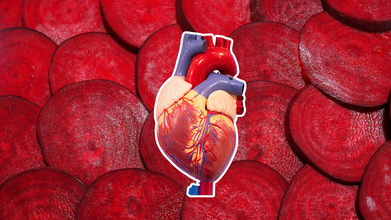- Health Conditions A-Z
- Health & Wellness
- Nutrition
- Fitness
- Health News
- Ayurveda
- Videos
- Medicine A-Z
- Parenting
Stress Relief In A Spoonful: What Are Adaptogens?

Image Credit: Canva
Stress has become a near-constant companion for many with financial concerns, health issues, work pressures, and more can create a perfect storm of stress that affects both mental and physical well-being. As stress levels continue to increase, especially post the COVID-19 pandemic, more and more people are searching for natural ways to ease the pressure. Among the most popular options are adaptogens-herbs and plants that help the body adapt to stress and restore balance.
But what exactly are adaptogens, and do they really live up to the hype?
Adaptogens have become increasingly popular, but there is limited scientific evidence to support these claims. Adaptogens are usually found in plants belonging to specific families, including Araliaceae and Asteraceae. Some natural adaptogens include ashwagandha, Rhodiola rosea, and Panax ginseng. Synthetic adaptogens also exist and can be purchased as supplements.
What are Adaptogens?
Adaptogens are plants and herbs thought to enable the body to better withstand stress. The supposed benefits of homeostasis-which these substances help create-mean that, if balanced within the body, the system would be less bothered by stress's effects on it both physically and psychologically. According to experts, they exert their actions on the HPA, a neuroaxis that helps govern stress responses, metabolic, and immunological actions.
Adaptogens are natural compounds that help the body adapt to stress through homeostasis, or balance. Adaptogens have been used in traditional medicine for thousands of years in Chinese and Ayurvedic practices. These plants have several health benefits that can offer relief from stress, improvement in exercise recovery, hormonal balance, and increased immunity.
As highly popular up they appear, such plants have been around for ages-thousands of years ago. Back in ancient India, practices through Ayurveda made several plants, herbs, and spices useful for their healing aspects, which were now classed as adaptogens. The term "adaptogen" was coined first back in 1947, by Russian scientist Nikolai Lazarev, whose research had shown how several herbs had the potential in stress relief.
Common Adaptogens and Their Benefits
Different types of adaptogens have a lot of unique benefits, each contributing to well-being in one way or the other. In most cases, people use adaptogens either in tea form, tinctures, or powders; however, some are suitable to add directly into your food. Here is some common used of adaptogens together with the associated benefits.
1. Ginseng
One of the well-known adaptogens is ginseng; it is included in tea and supplement types. Asian ginseng is named Panax ginseng and American ginseng named Panax quinquefolius. Ginseng, from research, aids in increased stamina, enhancement of energy levels, and strength to the immune system but also poses side effects, which may present as high blood pressure and elevated heart rate on some, so one needs to take caution.
2. Eleuthero (Siberian Ginseng)
Eleuthero, also known as Siberian ginseng, is another well-known adaptogen. It is said to increase energy and promote better sleep. Some research has indicated that eleuthero can also reduce fatigue and improve cognitive function. However, it can cause side effects such as drowsiness, anxiety, and irritability, especially when taken in large doses.
3. Schisandra
Schisandra is a fruit from Asia that has been used as medicine for thousands of years. This is known as the "five-flavor fruit," which provides benefits such as a healthy liver, reducing fatigue, and better quality sleep. However, if taken in large amounts, it may cause digestive issues like heartburn and stomach pain.
4. Ashwagandha
An example is an African Asian herbal medication, ashwagandha; one of the most investigated adaptogens worldwide. In effect, ashwagandha has sedative and antidepressive properties and may cause lower cortisol levels-the primary stress hormone-which tends to reduce anxiety.
Further, ashwagandha may cause better sleeping conditions and also improve an overall well-being condition; conversely, it induces gastrointestinal problems like diarrhea and stomach upset as well as nausea. The use of ashwagandha must be avoided in persons who have hyperthyroidism.
5. Rhodiola
Rhodiola is a plant root used in traditional Eastern medicine to combat stress, anxiety, and fatigue. It has been shown to help reduce mild depression and improve energy levels, making it an excellent option for individuals struggling with stress-related fatigue. However, it may interact negatively with medications for high blood pressure, antidepressants, or central nervous system drugs.
6. Tulsi (Holy Basil)
Holy basil, also called tulsi, is a fragrant herb that is widely utilized in Ayurvedic practice. It is believed to help reduce stress levels and better mental health. Some reports indicate that holy basil can mitigate anxiety and improve cognitive functions; however, it can have an effect on thyroid medicines and can cause bleeding disorder, so patients on anticoagulant medications should be precautious.
7. Cordyceps
This is a Chinese fungus that grows on caterpillar larvae and has been used over centuries to boost energy and increase vitality. It has shown some immune-boosting action and may help enhance body functions. However, the intake of cordyceps may lead to the possibility of bleeding issues so is not recommended for persons using blood-thinning medicines.
8. Reishi Mushroom
Reishi mushrooms can be very relaxing and increase immune function. They also tend to help support adrenal functions, which help the body respond to stress. On the other hand, reishi mushrooms may have some side effects like nausea and insomnia, but they are not advisable to those on blood thinners or with compromised immune system.
Possible Side Effects and Risk
While adaptogens can provide many benefits, they have a dark side as well. Unregulated supplement industries lead to inconsistencies in quality control, such that the purity and potency may vary from product to product. Adaptogens also are known to interact with prescribed medication, especially hormones, blood pressure, and immunes.
One must seek medical advice before including adaptogens in their diet, especially if they are pregnant or breastfeeding or are taking prescription medications. Some of the adaptogens, for instance ashwagandha, rhodiola, and holy basil, have been found to have hormonal activity, which may be unsafe in pregnant and breastfeeding women.
Food That Cause Stress
In addition to the inclusion of adaptogens, there are foods that increase stress.
Diets high in processed foods, sugars, and artificial sweeteners can contribute to inflammation and blood sugar imbalances, which in turn affect mood and stress levels. Too much sugar can cause spikes and crashes in blood sugar, which can mimic symptoms of anxiety or panic attacks.
A diet rich in fruits, vegetables, whole grains, and lean proteins can help reduce stress. However, it is worth being wise enough on adaptogens, as more and more attention has gained stress-relieving properties.
One's effectiveness may vary since each person is unique, but the benefits and risks from this herb still need some research. Therefore, consulting a healthcare provider is indispensable before adding them to one's routine, especially those with pre-existing health conditions or taking medication.
How Do Adaptogens Work?
Adaptogens act on numerous tissues and organs. They affect the hypothalamic-pituitary-adrenal axis, which manages stress reactions, and the substances which include cortisol, blood sugar, and lipids. Some of the possible effects include improved control over stress, increased mental and physical endurance, quality sleep, and hormonal balancing.
Although research on adaptogens is continually expanding, they are generally safe and useful in enhancing well-being. However, there still is a need for a greater number of studies in relation to their mechanisms and overall health impact.
Basically, dealing with stress is a holistic approach; a lot of it is about healthful lifestyle habits, good eating, regular exercise, and mindfulness practices. Adaptogens would help to an extent but should be taken as one of the other strategies meant to help individuals deal with the stresses of modern living.
The effect of adaptogenic plants on stress: A systematic review and meta-analysis. Journal of Functional Foods. 2023
Are Diet Sodas Really Safe? New Research Points To Liver Risk

Credits: Canva
Most people assume that low- or no-sugar drinks are a healthier alternative to regular sodas, but new research suggests that might not be the full picture. A large-scale study presented at UEG Week 2025 found that both sugar-sweetened beverages (SSBs) and low- or non-sugar-sweetened beverages (LNSSBs) are linked to an increased risk of developing metabolic dysfunction-associated steatotic liver disease (MASLD), a condition previously known as non-alcoholic fatty liver disease.
What Is MASLD?
According to the Cleveland Clinic, MASLD—short for metabolic dysfunction-associated steatotic liver disease, is a condition in which extra fat accumulates in the liver. It was previously called nonalcoholic fatty liver disease (NAFLD). Unlike liver damage caused by heavy drinking, MASLD is linked to metabolic risk factors such as obesity, type 2 diabetes, high blood pressure, and high cholesterol. If left untreated, it can progress to more serious liver problems.
What The Study Found
Researchers analyzed data from 123,788 participants in the UK Biobank who did not have liver disease at the start of the study. Participants reported their beverage consumption through multiple 24-hour dietary questionnaires, giving researchers insight into how both sugary and “diet” drinks might affect liver health.
The results were striking: individuals consuming more than 250 grams per day of either SSBs or LNSSBs faced significantly higher risks of MASLD, about 60% higher for LNSSBs and 50% higher for SSBs. Over a median follow-up of 10.3 years, 1,178 participants were diagnosed with MASLD, and 108 died from liver-related causes. Interestingly, LNSSBs, but not SSBs, showed a notable link to liver-related mortality. Both drink types were also tied to increased liver fat.
Understanding MASLD and Its Growing Impact
MASLD occurs when excess fat builds up in the liver, which can eventually lead to inflammation, fatigue, abdominal pain, and loss of appetite. Once considered less common, MASLD has now become the most widespread chronic liver disease globally, affecting more than 30% of the population. It is also emerging as a leading cause of liver-related deaths worldwide.
Lead author Lihe Liu emphasized, “SSBs have long been scrutinized, while their ‘diet’ counterparts are often seen as a healthier choice. Our study shows that both types of beverages are widely consumed, yet their effects on liver health have not been fully understood.”
Liu added, “Even modest consumption of LNSSBs, like a single can per day, was linked to a higher risk of MASLD. These findings challenge the perception that ‘diet’ drinks are harmless and highlight the need to reconsider their role in our diets, especially as MASLD continues to grow as a public health concern.”
Why Both Sugary and Diet Drinks May Harm the Liver
The researchers explained potential mechanisms behind the risks. SSBs, with their high sugar content, can spike blood glucose and insulin, promote weight gain, and increase uric acid levels, all contributing to liver fat accumulation. LNSSBs may affect liver health differently: by altering the gut microbiome, disrupting feelings of fullness, triggering sugar cravings, or even stimulating insulin secretion.
Water Remains the Safest Choice
Experts recommend limiting both sugar-sweetened and artificially sweetened beverages. Replacing either type with water showed a significant reduction in MASLD risk, about 13% for SSBs and 15% for LNSSBs. Simply switching between SSBs and LNSSBs did not reduce risk.
The researchers plan to investigate causal mechanisms more deeply with long-term studies, including randomized and genetic trials. They aim to better understand how sugar and its substitutes interact with the gut microbiome and influence liver disease.
This Vegetable Could Prevent Arterial Plaque Buildup

Credits: Canva
Arterial plaque buildup is one of the biggest drivers of heart disease, yet most people don’t realise how silently it develops. When fatty deposits, cholesterol, calcium, and cellular waste accumulate along the artery walls, they gradually harden and narrow the vessels, a condition known as atherosclerosis. This restricts blood flow, makes the heart work harder, and increases the risk of heart attack and stroke.
While medication and lifestyle changes are standard recommendations, growing research, including a study by the University of Sunshine Coast, Australia, suggests that one everyday food may offer surprising protection: beetroot.
Why Arterial Blockage Happens
Plaque develops over years. High levels of LDL cholesterol damage the artery lining, allowing lipids to stick and form deposits. Inflammation accelerates this process, making the plaque harder and more unstable. When a plaque ruptures, it can trigger a clot that blocks blood flow completely, leading to a heart attack. Because early atherosclerosis has almost no symptoms, prevention becomes essential.
Beetroot: A Natural Artery-Friendly Food
Beetroot has emerged as one of the most heart-friendly foods due to its exceptional nutritional profile. Rich in nitrates, antioxidants, fibre, minerals, and bioactive compounds, it is being studied for its ability to influence blood pressure, reduce inflammation, and possibly slow arterial stiffening, all key factors in preventing plaque formation.
Lowers Blood Pressure Naturally
One of the best-researched benefits of beetroot is its effect on blood pressure. Dietary nitrates in beets convert into nitric oxide, a molecule that helps arteries relax, expand, and carry blood more efficiently. Clinical studies show that drinking beetroot juice can lower systolic blood pressure by 4–10 mmHg within hours. Over time, this improved vascular flexibility may reduce strain on the heart and keep arteries healthier.
Reduces Inflammation, a Key Driver of Plaque
Chronic inflammation is a major contributor to plaque buildup. Beetroots contain betalains, powerful antioxidants with anti-inflammatory properties. Research suggests these compounds may help lower markers of inflammation in the body, ultimately slowing the progression of arterial damage.
May Limit Arterial Stiffness
Arterial stiffness is a strong predictor of heart attack and stroke. Studies have found that beetroot juice can reduce arterial stiffness in both young adults and older individuals. More flexible arteries allow for smoother blood flow, reducing the pressure that contributes to plaque formation and rupture.
Improves Muscle Recovery and Heart Efficiency
Beetroot has been found to improve oxygen efficiency in the body, meaning muscles — including the heart — need less effort to perform the same tasks. This can indirectly protect the cardiovascular system, especially during physical exertion.
Supports a Healthy Cholesterol Balance
The fiber and antioxidants in beetroot may help improve lipid levels by lowering LDL cholesterol and supporting the removal of excess fats. While not a substitute for medication, it complements a heart-healthy diet.
Looking For A Health Smoothie Recipe, Study Says You Should Skip The Banana

(Credit-Canva)
If you're making a smoothie for a health boost, especially for your brain and heart, you might want to leave out bananas. New research suggests that adding a banana to your drink can actually block your body from absorbing key healthy compounds.
Bananas have always been a big favorite for healthy drinks and desserts. You may have seen many healthy smoothie recipes like banana and coffee smoothie, or bananas and berries, being listed along with other healthy food recipes. While it does have many health benefits, how healthy it is with other nutrients involved has been questioned.
Researchers at the University of California-Davis found that bananas interfere with the absorption of powerful nutrients called flavanols. These compounds are fantastic for health, but if you blend them with a banana, you might not get the benefit you're looking for.
Should You Add Bananas In Health Smoothies?
The researchers found that bananas block how well we absorb flavanol. Flavanols are beneficial natural chemicals found in foods like berries, apples, grapes, and cocoa. When you eat enough of them regularly, they are known to help your memory, reduce swelling inside your body, which is called inflammation, and make your blood flow better.
So, why does the banana stop this? The culprit is a specific enzyme, a kind of protein, that is found in high amounts in bananas. It's called polyphenol oxidase (PPO). This is the same enzyme that makes a peeled banana or apple slice turn brown quickly. The researchers found that when PPO mixes with flavanols in the blender, it somehow stops your body from being able to use them. Lead researcher Javier Ottaviani said it was surprising to see how quickly even just one banana dropped the levels of flavanols your body could absorb.
Why Do Bananas Block Nutrients?
The scientists conducted a very clear experiment to figure this out. They had people drink three different things and then measured the flavanols in their bodies, by testing their blood and urine:
The Banana Test
A smoothie made with banana, which is high in the PPO enzyme.
The Berry Test
A smoothie made with mixed berries, which are low in the PPO enzyme.
The Control Test
A plain capsule of pure flavanols, just to see what 100% absorption looked like.
The results were impossible to ignore, the people who drank the banana smoothie had 84% less flavanols show up in their system compared to the people who took the pure flavanol capsule. This clearly proved that the banana was the reason the healthy compounds weren't getting absorbed.
How to Get Your Daily Flavanols?
If you're trying to meet the daily recommendation of flavanols, which is about 400 to 600 milligrams, to help your heart and overall health, you need to be smart about your smoothies.
The main takeaway is to skip the bananas if you're mixing it with high-flavanol foods like berries. If your smoothie already contains ingredients that are low in the PPO enzyme—like berries, pineapple, oranges, mango, or yogurt—then you are maximizing the amount of healthy flavanols your body will actually get. This finding opens the door for more research into how simple acts of cooking or preparing food, like how you brew tea (a major flavanol source), can change the nutrients you absorb.
© 2024 Bennett, Coleman & Company Limited

